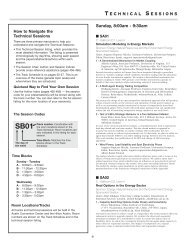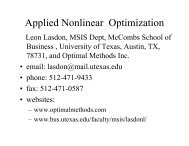Sunday
Sunday
Sunday
Create successful ePaper yourself
Turn your PDF publications into a flip-book with our unique Google optimized e-Paper software.
SA49<br />
■ SA49<br />
49- North 231 B- CC<br />
Joint Session TSL/SPPSN: Geographic, Building and<br />
Pedestrian Evacuation Modeling<br />
Sponsor: Transportation Science & Logistics & Public Programs,<br />
Service and Needs<br />
Sponsored Session<br />
Chair: Douglas Bish, Assistant Professor, Virginia Tech, Department of<br />
Industrial and Systems Eng., 250 Durham Hall, Blacksburg, VA, 24061-<br />
0118, United States of America, drb1@vt.edu<br />
1 - Simulating Pedestrian Evacuation from Large Events<br />
Pitu Mirchandani, Arizona State University, 699 South Mill<br />
Avenue, Tempe, AZ, 85287, United States of America,<br />
pitu@asu.edu, Ning Wang, Zhuoyang Zhou<br />
At the end of a large event, attendees move from their seats to an exit, and then<br />
walk over to the vehicle, which they subsequently use to reach their ultimate<br />
destination. This paper develops a simulation model, using the pedestrian feature<br />
in VISSIM, to evaluate delays in normal and no-notice evacuation scenarios.<br />
Evacuation strategies are studied to make total evacuation time to leave the<br />
building or stadium and reach respective destinations as small as possible.<br />
2 - Pedestrian Route Choice Modeling in a Changing<br />
Physical Environment<br />
Lei Feng, University of Maryland, College Park, MD,<br />
United States of America, lfeng@umd.edu, Elise Miller-Hooks<br />
The selection of routes in a congested pedestrian network in which the physical<br />
environment is changing is explored. Models of route choice behavior in this<br />
environment are developed. The evolving physical conditions, improving<br />
pedestrian situational awareness, responsively changing goals, and individual and<br />
collective responses are explicitly recognized in these models of route choice.<br />
3 - Fleet Management and Equity Measures in Evacuation<br />
Transportation Planning for Multiple Hospitals<br />
Esra Agca, PhD Student, Virginia Tech, Department of Industrial<br />
and Systems Eng., 250 Durham Hall, Blacksburg, VA, 24061,<br />
United States of America, esra.vt@gmail.com, Douglas Bish,<br />
Roger Glick<br />
A coordinated response is required for to effectively evacuate multiple hospitals<br />
due to a regional threat (e.g., a hurricane). Organizing the evacuation response<br />
can be more complicated when it involves more than one hospital system (groups<br />
of hospitals under the same management). In this research we study optimal<br />
evacuation plans for multiple hospitals, including full centralized control, and the<br />
study of equity issues at various levels, including at the hospital system level.<br />
4 - Optimizing a Large Scale Evacuation Plan for Tucson, AZ<br />
Neema Nassir, Graduate Research Assistant, University of Arizona,<br />
Department of Civil Engineering and Engineering Mechanics,<br />
1209 E. Second Street, Tucson, AZ, 85721-0072,<br />
United States of America, neeman@email.arizona.edu,<br />
Hong Zheng, Mark Hickman, Yi-Chang Chiu<br />
Every year hundreds of chlorine tankers pass through downtown Tucson. This<br />
study aims to optimize evacuation under a hypothetical tanker spill. Current gas<br />
dispersion models indicate that such a spill may lead to deadly consequences for<br />
many persons in this large urban area. In our evacuation model, the objective is<br />
to minimize the total exposure of the citizens to the poisonous gas, taking into<br />
account the different concentration levels of gas over the space.<br />
■ SA50<br />
50- North 231 C- CC<br />
Military Applications<br />
Sponsor: Military Applications<br />
Sponsored Session<br />
Chair: Sung-Pil Kim, Yonsei University / R.O.K Navy, Yonseiro 50,<br />
Seoul, Korea, Republic of, senseksp@gmail.com<br />
1 - Modeling Multi-echelon Inventories for Naval Repair Parts in<br />
the ROK Navy<br />
Sung-Pil Kim, Yonsei University/R.O.K Navy, Yonseiro 50, Seoul,<br />
Korea, Republic of, senseksp@gmail.com<br />
In comparison to the rapid modernization of defense equipment, government<br />
resources are restricted, necessitating an efficient solution for managing all<br />
national resources, including naval repair parts.This paper investigates the<br />
modeling of efficient multi-echelon inventory management of naval repair parts<br />
in the ROK Navy.<br />
INFORMS Phoenix – 2012<br />
72<br />
2 - Once More: Putting the “O” Back into Military<br />
Operations Research<br />
George Kuhn, LMI, 2000 Corporate Ridge, McLean, VA, 22102,<br />
United States of America, GKuhn@lmi.org<br />
Research results are described for two core military management topics:<br />
estimating Forces personnel attrition (casualty estimation), and forecasting unitlevel<br />
requirements for aircraft (helicopter) spare parts. While being clearly<br />
different planning domains on one level, at another level the difficulties that have<br />
long burdened estimating/forecasting such requirements share a common root:<br />
unless data collection and analysis are grounded on capturing and reflecting the<br />
inherent character of military operations, estimates/forecasts will inevitably fail to<br />
describe requirements accurately. Evidence is presented that, properly grounded<br />
on describing patterns of military operations, quantitative analysis can project<br />
requirements accuratelyóand these results differ markedly from standard<br />
portrayals that rely on conceptual and quantitative conventions incongruent with<br />
the underlying character of military operations.<br />
■ SA51<br />
51- North 232 A- CC<br />
Disaster Relief Planning and Operations<br />
Sponsor: Military Applications<br />
Sponsored Session<br />
Chair: Xiaofeng Nie, Assistant Professor, Nanyang Technological<br />
University, 50 Nanyang Avenue, Singapore, 639798, Singapore,<br />
xiaofengnie@ntu.edu.sg<br />
1 - Prepositioning of Supplies in Preparation for a Hurricane with<br />
Forecast Information Updates<br />
Rajan Batta, University at Buffalo (SUNY), Dept. of Industrial &<br />
Systems Engg, Buffalo, NY, 14260, United States of America,<br />
batta@buffalo.edu, Gina Galindo<br />
It is possible to use prediction models to obtain periodic forecasts about a<br />
hurricane’s main characteristics such as its path, wind force and time of landfall.<br />
Using this information we present a dynamic model for prepositioning supplies in<br />
such a setting. Our model has two distinguishing features: possible destruction of<br />
supply points during the disaster event, and the use of forecast information<br />
updates in order to strategically modify and improve the prepositioned quantities<br />
and locations.<br />
2 - A Stochastic Programming Model for Casualty Response<br />
Planning during Catastrophic Health Events<br />
Aakil Caunhye, PhD Student, Nanyang Technological University,<br />
758, Choa Chu Kang North 5, Singapore, 680758, Singapore,<br />
M090028@e.ntu.edu.sg, Xiaofeng Nie<br />
Catastrophic health events are natural or man-made incidents that create<br />
casualties in numbers that overwhelm healthcare response capabilities. We<br />
construct a three-stage stochastic programming model to locate alternative care<br />
facilities and transport casualties in response to such events. We also propose an<br />
L-shaped cut algorithm, to generate good solutions fast. We analyse the model<br />
and algorithm in the case of a high-impact earthquake in a subregion of San<br />
Bernardino, California.<br />
3 - Identifying the Role and Impact of Social Media in Evacuation<br />
Justin Yates, Assistant Professor, Texas A&M University, 4079 ETB,<br />
3131 TAMU, College Station, TX, 77843-3131, United States of<br />
America, jtyates@tamu.edu<br />
The next generation of evacuation planning and emergency response strategies<br />
needs to be built on the context of real-time information dissemination.<br />
The goal of this research is to build a new set of evacuation models capable of<br />
incorporating spatio-temporal data on extremely large scales and supported by<br />
new behavioral paradigms predicated on the use of social media. We discuss our<br />
initial efforts and insights in this presentation.<br />
4 - Heuristic Methods for Hazard Zone Determinations<br />
Ed Pohl, University of Arkansas, Department of Industrial<br />
Engineering, Fayetteville, AR, United States of America,<br />
epohl@uark.edu, Manuel D. Rossetti<br />
To better examine the use of optimization in emergency planning this research<br />
investigates the determination of hazard zones within a geographic area. A hazard<br />
zone is an area corresponding to a worst-case evacuation scenario and is a<br />
potential vulnerability that should be addressed by risk mitigation strategies. The<br />
research compares two heuristic approaches to determining hazard zones based<br />
on population and road connectivity within a spatial network.



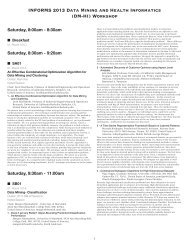
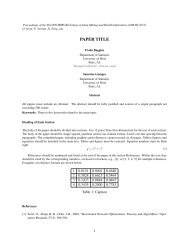
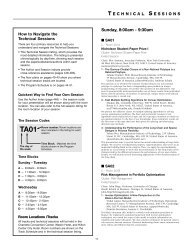
![[PDF] Charlotte Back Matter](https://img.yumpu.com/17933057/1/190x245/pdf-charlotte-back-matter.jpg?quality=85)


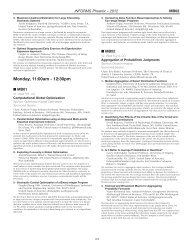
![[PDF] ALIO Back Matter](https://img.yumpu.com/17932960/1/190x245/pdf-alio-back-matter.jpg?quality=85)

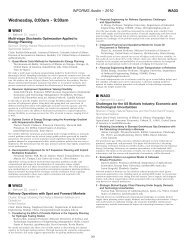
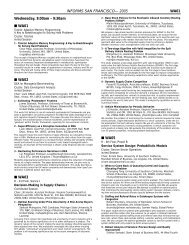
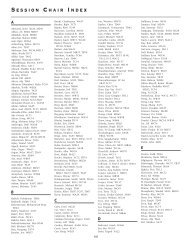
![[PDF] Monday, 8:00am - 9:30am](https://img.yumpu.com/17932954/1/190x245/pdf-monday-800am-930am.jpg?quality=85)
